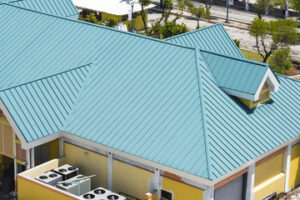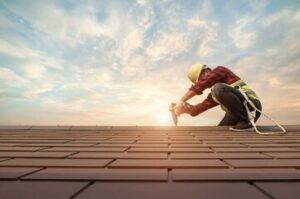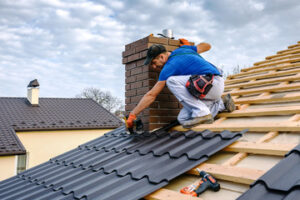Metal Roofing Erie PA is a smart investment that adds to the value of your home. It also offers long-term energy efficiency benefits.

Choose from a wide selection of panel options including corrugated, standing seam, and paradise panels. Complement your style with trims, sealants and clips. Metal roofs are also compatible with cool roof coatings that reduce energy consumption.
A metal roof offers excellent weather resistance, and this durability enhances a property’s ability to withstand harsh environmental conditions. This resilience helps homeowners and commercial property owners enjoy long-term cost savings, as well as the peace of mind that comes with knowing their investment is protected against severe storms.
A durable metal roof can withstand heavy wind and hail storms, as well as snow and other ice buildups. It also reflects solar heat rather than absorbing it, which can reduce cooling costs in the summer and heating costs during winter.
Most residential and commercial property owners choose a galvanized or Galvalume steel roof due to their corrosion-resistant properties. These materials offer a lifespan of up to 60 or 70 years, respectively. They also feature a Class A fire rating, preventing the spread of flames and smoke.
Choosing the right metal roof for your property largely depends on local environmental challenges and climate. If you live near the ocean, consider copper and zinc roofing options that are resistant to salty air. On the other hand, if budget is a priority, aluminum and galvanized steel roofing provide an affordable alternative to copper with similar longevity and corrosion resistance.
To maximize the durability of a metal roof, choose a contractor with a strong track record and extensive experience in metal roofing. Ask about their certifications and references, as well as their warranty policy to gauge the reliability of their services. They should be able to provide comprehensive documentation that clearly outlines material and workmanship warranties, as well as a thorough list of maintenance and repair services. Regular inspections are also important, as they help identify any damage or leaks early and address them promptly.
Energy Efficiency
If you’re concerned about the environment, maximizing energy efficiency is one of your best ways to make a difference. Lowering energy usage helps reduce the amount of fossil fuels needed to heat and cool your home, and it cuts down on both your utility bills and your carbon footprint.
Metal roofs are excellent choices for energy efficiency, thanks to their reflective surfaces that bounce back most of the sun’s rays, reducing cooling costs during the summer months and minimizing the strain on your HVAC system. This is particularly important in hot climates, where high energy bills are common.
Aside from lowering your energy bill, metal roofs are also excellent protection against severe weather conditions that can cause damage to homes and businesses. Their hard surface is much more resistant to hail than shingle roofs, preventing costly repairs and replacements in the long run.
When installing a metal roof, you have the option to add a radiant barrier underlayment to further increase your energy savings. A study by R&D Engineering found that this type of underlayment increased energy efficiency by up to 113.9% when installed on battens, and 77.8% when installed directly to the roof (read more here).
As such, a metal roof is an ideal choice for sustainable and net-zero energy (NZE) homes and buildings. These buildings produce as much or more energy than they consume, resulting in impressive cost and environmental savings. Adding a metal roof to a NZE home or building can help you achieve your energy-saving goals, and may even qualify you for federal and state tax incentives.
Aesthetics
Metal roofing goes beyond a roof’s performance and longevity—it’s also a stunning design choice that elevates any structure. Thanks to a wide range of color options and textures, homeowners can create their desired aesthetic for their home or commercial property. The possibilities are endless, ranging from earthy tones that complement a natural facade to vibrant hues that make a statement.
When it comes to choosing a color for your metal roof, consider the architectural style of your building and any HOA regulations in your neighborhood. Also, think about the climate and your energy efficiency needs, as lighter colors reflect sunlight, which can lower cooling costs in warmer areas.
Besides a broad array of color choices, metal roofing also offers several texture options that add depth and dimension to your property’s façade. Choose a smooth finish for an elegant, contemporary aesthetic or opt for textured patterns that mimic slate, shingles, and tiles for a traditional look. Textured finishes are also more durable and can reduce glare and improve contrast for an overall more aesthetically pleasing appearance.
If you’re looking for a stylish, modern look, consider steel shake-inspired or tiled roofing. These styles offer a clean and contemporary appearance that can boost your home’s curb appeal. In addition, metal roofs can replicate the appearance of more expensive roofing materials, providing a cost-effective alternative without sacrificing visual appeal.
Maintaining the historic integrity of a building while improving its functionality and durability can be a delicate balance. However, advances in metal roofing technology offer both the aesthetics and durability necessary to achieve a successful renovation. Keeping up with regular maintenance, including inspections for potential problems like sealant failure or loose fasteners, is critical to maintaining your metal roof’s beauty.
Longevity
When compared to traditional roofing materials, metal roofs deliver superior longevity. Providing decades of protection, the longevity of a metal roof can be improved with regular maintenance and repairs.
The climate in which a building is located also impacts the longevity of a metal roof. High winds, hail, heavy snow, and severe heat or cold will affect the durability of a metal roof, requiring that it be repaired or replaced more frequently than a roof in a milder climate.
While the longevity of a metal roof is an impressive attribute, it must be balanced against its upfront cost. Unlike other roofing products, a metal roof can be more expensive than other options during installation. However, the long lifespan and energy savings that a metal roof provides can offset the initial financial outlay.
Metal roofing also offers a range of aesthetic options. Whether a property manager is seeking a modern, industrial look or a more classic design, a variety of panel styles, finishes, and colors are available. This versatility allows a building to achieve its desired aesthetic while remaining functional and protective.
Investing in a metal roof that features cool roof coatings and reflective surfaces promotes energy efficiency, lowering heating and cooling costs for the building. In addition, this type of roofing can support LEED certification and other sustainability goals for facility managers. Moreover, metal roofing systems are fully recyclable at the end of their lifespan, contributing to sustainable building practices. This inherent value makes metal roofs a sound investment for building owners. However, a metal roof should be inspected regularly for signs of wear and tear. A small issue like a loose fastener or rust spot can cause significant damage over time. Regular inspections allow professionals to address minor issues before they worsen.
Maintenance
As with any roof, the performance of metal roofing can be improved and its lifespan extended by regularly completing maintenance tasks. These include surface cleaning, inspections, and promptly addressing any issues that arise. In addition, the right contractor can help identify issues that might occur in the future and address them before they escalate to more serious problems.
In terms of surface maintenance, a metal roof should be regularly cleaned using a soft-bristle broom or low-pressure power washer to remove debris and dirt. This will prevent the buildup of moisture that can cause premature degradation. In addition, the roof should be inspected for signs of damage or rust formation. It is also recommended to inspect the roof twice a year, particularly in spring and fall. Inspecting the roof can reveal loose panels or fasteners, and can spot any other signs of wear or tear that require immediate attention.
Metal roofing can be installed in a variety of styles to suit any architectural style. From sleek standing seam panels to metal shingles that mimic the look of slate or clay tiles, there is a style to match any taste. In addition, the range of finishes available is impressive – matte, glossy, textured and more.
The most challenging aspect of metal roof maintenance is the repair of any damaged areas. This requires detailed inspection and sometimes water testing to accurately diagnose the issue, and precise repairs that maintain structural integrity. It is also important to correctly match the color and finish of any replacement parts with the existing roof to achieve an aesthetically pleasing result.

